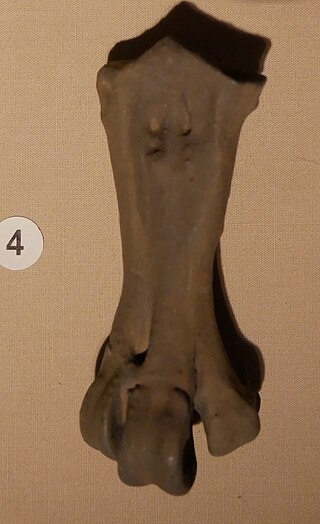
Charadriiformes is a diverse order of small to medium-large birds. It includes about 390 species and has members in all parts of the world. Most charadriiform birds live near water and eat invertebrates or other small animals; however, some are pelagic (seabirds), others frequent deserts, and a few are found in dense forest. Members of this group can also collectively be referred to as shorebirds.
The Late Cretaceous is the younger of two epochs into which the Cretaceous Period is divided in the geologic time scale. Rock strata from this epoch form the Upper Cretaceous Series. The Cretaceous is named after creta, the Latin word for the white limestone known as chalk. The chalk of northern France and the white cliffs of south-eastern England date from the Cretaceous Period.

Vegavis is a genus of extinct bird that lived during the Late Cretaceous of Antarctica, some 68 to 66 mya. Among modern birds, most studies show that Vegavis is most closely related to ducks and geese (Anatidae), but it is not considered to be a direct ancestor of them, although other studies question these results.

Waimanu is a genus of early penguin which lived during the Paleocene, soon after the Cretaceous–Paleogene extinction event, around 62–60 million years ago. It was about the size of an emperor penguin. It is one of the most important bird fossils for understanding the origin and evolution of birds because of the time period it comes from, and the position of penguins near the base of the bird family tree.

Ichthyornithes is an extinct group of toothed avialans very closely related to the common ancestor of all modern birds. They are known from fossil remains found throughout the late Cretaceous period of North America, though only two genera, Ichthyornis and Janavis, are represented by complete enough fossils to have been named. Ichthyornitheans became extinct at the Cretaceous–Paleogene boundary, along with enantiornitheans, all other non-avian dinosaurs, and many other animal and plant groups.
Polarornis is a genus of prehistoric bird, possibly an anserimorph. It contains a single species Polarornis gregorii, known from incomplete remains of one individual found on Seymour Island, Antarctica, in rocks which are dated to the Late Cretaceous.

The Pelagornithidae, commonly called pelagornithids, pseudodontorns, bony-toothed birds, false-toothed birds or pseudotooth birds, are a prehistoric family of large seabirds. Their fossil remains have been found all over the world in rocks dating between the Early Paleocene and the Pliocene-Pleistocene boundary.
Neogaeornis is a controversial prehistoric genus of diving bird. The single known species, Neogaeornis wetzeli, was described from fossils found in the Campanian to Maastrichtian Quiriquina Formation of Chile. It lived about 70-67 million years ago. It remains known from the single tarsometatarsus described in 1929 by Lambrecht, and today housed in the Paläontologisches Institut und Museum in Kiel, Germany.
Novacaesareala is a genus of prehistoric bird. It is known only from the fossil remains of a single partial wing of the species Novacaesareala hungerfordi. This was found in Hornerstown Formation deposits, probably from the latest Cretaceous (Maastrichtian) or Early Paleocene (Danian); it lived around 66-65 million years ago on the western shores of the Atlantic, where now is New Jersey.
Paleontology or palaeontology is the study of prehistoric life forms on Earth through the examination of plant and animal fossils. This includes the study of body fossils, tracks (ichnites), burrows, cast-off parts, fossilised feces (coprolites), palynomorphs and chemical residues. Because humans have encountered fossils for millennia, paleontology has a long history both before and after becoming formalized as a science. This article records significant discoveries and events related to paleontology that occurred or were published in the year 2002.

The Phaethontiformes are an order of birds. They contain one extant family, the tropicbirds (Phaethontidae), and one extinct family Prophaethontidae from the early Cenozoic. Several fossil genera have been described, with well-preserved fossils known as early as the Paleocene. The group's origins may lie even earlier if the enigmatic waterbird Novacaesareala from the latest Cretaceous or earliest Paleocene of New Jersey is considered a tropicbird.

Pelagornis is a widespread genus of prehistoric pseudotooth birds. These were probably rather close relatives of either pelicans and storks, or waterfowl, and are placed here in the order Odontopterygiformes to account for this uncertainty.

Crossvallia is an extinct genus of penguins. It includes two species, C. unienwillia and ?C. waiparensis. Their anatomy suggests that the genus is closely related to the Anthropornithinae.

Vegaviidae is an extinct family of ornithurines, often regarded as stem-anseriforms, which existed during the Late Cretaceous and possibly the Paleocene. Fossils attributed to the family have been found in Canada, Chile, New Zealand, and Antarctica.

Kumimanu is an extinct genus of giant penguin, which lived around 60 to 56 million years ago. The type species is K. biceae, which arose after the extinction of the non-avian dinosaurs. Fossils were found in New Zealand, and the discovery was announced in December 2017. A second species, Kumimanu fordycei, was named in February 2023.
Muriwaimanu is an extinct genus of early penguin.
Sequiwaimanu is an extinct genus of early penguin. The type species, Sequiwaimanu rosieae, was named and described by Gerald Mayr in 2018.
The Waipara Greensand is a geological rock unit found in Canterbury, New Zealand. It dates from just after the Cretaceous–Paleogene extinction event, the Thanetian and Selandian, around 61–62 million years ago in the early Palaeocene. It is well known for its fossils, particularly for containing the oldest penguins (Sphenisciformes).
Petradyptes is an extinct genus of penguin that lived during the Late Paleocene epoch, between 60 and 55 million years ago. The genus currently contains one known species, Petradyptes stonehousei.

Clymenoptilon is an extinct genus of phaethontiform bird related to modern tropicbirds. It contains a single species, C. novaezealandicum from the Paleocene-aged Waipara Greensand of New Zealand. Its name references Clymene, the mother of Phaethon in Greek mythology.

















